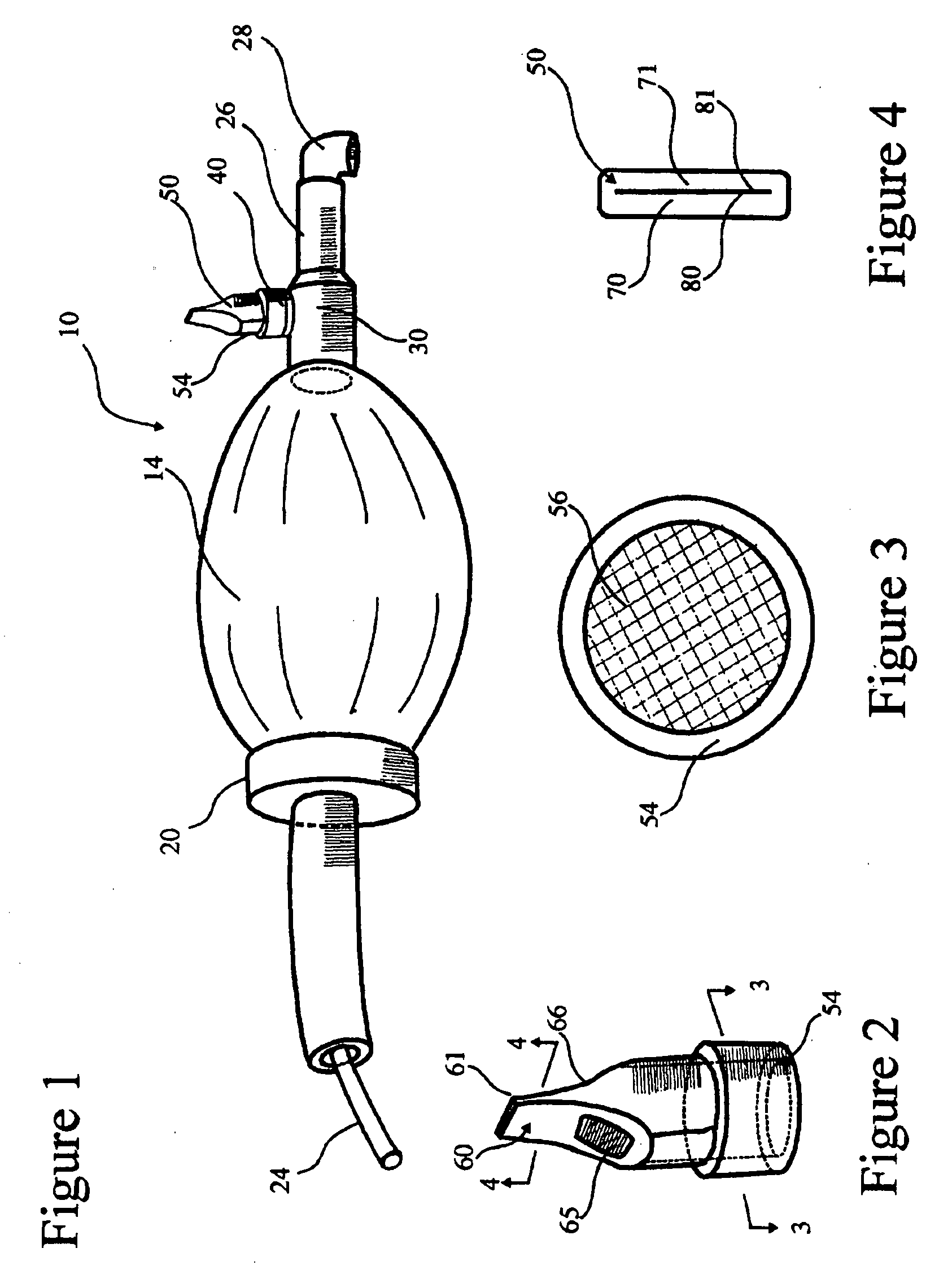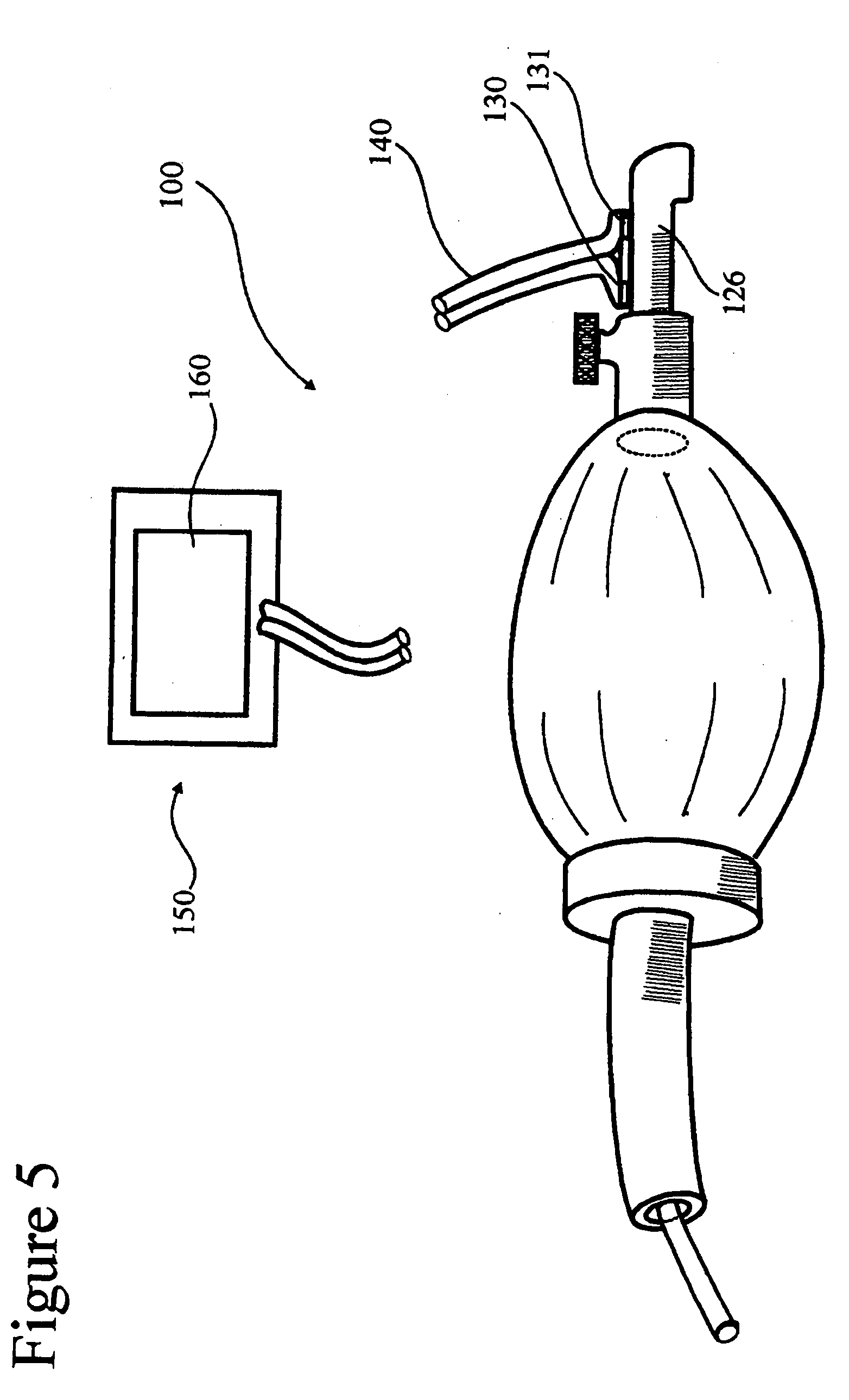[0005]It is considered important that any new medical resuscitated bag have a low manufacturing cost, as most resuscitation bags are now disposable. The present inventors recognized that it is important that all bags provide an indicator of
trapped air both in the field and in the hospital. For this reason it is considered desirable to provide an embodiment of the indicator which is inexpensive and disposable, so that comprehensive implementation is easily achieved.
[0006]The present invention comprises a simple resuscitation bag
system including a bag having a port for connection to an
oxygen source, a conduit with a terminal for connection with an indwelling
endotracheal tube, a one way valve intermediate the bag and the terminal to prevent
exhalation back into the bag, an exhalation port, and an indicator connected with said
system which indicates when pressure and / or
airflow from the patient is present after the
inhalation has been completed. The indicator allows the recognition of
trapped air during bagging so that survival in patients with
obstructive lung disease or low
blood volume can be improved during CPR. The pressure or flow indicator can be adjacent the bag or adjacent the connecting tubing between the patient and is preferably mounted adjacent with or is integral with the exhalation port. The indicator can be a simple pressure or flow sensing device such as a disposable pneumotachometer or other type of flow and / or
pressure sensor as are well known in the art. The indicator is sized and configured to provide automatic visual or auditory indication of persistent
airflow or pressure during exhalation so that the exhalation does not need to be stopped or any changes made by the operator to identify the presence of persistent flow which can indicate air which will be trapped if the bag in manually compressed before the exhalation process in completed. In the preferred embodiment the indicator is a simple disposable elastomeric member which is mounted adjacent the exhalation conduit of a resuscitation bag or
endotracheal tube and which is positioned so as to be readily visible to the operator and which deforms in the presence of flow and / or pressure such that the presence of said deformation can be used to indicate the persistence of flow and / or pressure during exhalation after a manual inflation of the lungs by the bag system.
[0007]In another preferred embodiment of the invention, the indicator consists of an auditory port located through the side of the exhalation port to which a listening device such as a disposable esophageal
stethoscope is connected. The esophageal
stethoscope is comprised of a long flexible tube with a standard fitting, such as a Luerlok fitting, at one end and an earpiece at the other end, a design well known in the art. The earpiece is placed in the ear of the operator / rescuer. Gas flow is detected by the sound of gas flowing through the exhalation port and into the ambient environment. A small protuberance is located on the interior wall of the exhalation port and in proximity to the auditory port to enhance the level of sound. In a further improvement to this embodiment, a whistle is mounted on the interior of the exhalation port and in proximity to the auditory port. The whistle generates a sound in the human auditory range of frequencies as gas flows through it. Gas flow is then detected, after a manual inflation of the lungs by the bag system, by the sound generated by the whistle.
[0011]The provision of a manikin simulating the
physiology of asthma with basic elastic or inelastic
airway narrowing (as by the of a simple inelastic ring or elastic ring inserted in, mounted with and / or integral with the
airflow path. Both narrow elastic airways, or a fixed narrowing or valve within the airways has the advantages of simplicity and low cost. For example, one low cost embodiment includes an elastic ring (such as a
thin wall elastic
silicone, poly-
isoprene or
latex rubber band ring of approximately 2-4 cm in width having a internal
diameter in its resting state less than that of the
airway) mounted along the airway. The band is mounted so that it can be selectively movable along the airway from a first position wherein the ring is mounted over rigid portion of the airway (so that no airway narrowing or restriction to airflow is provided) to a second position along a compressible portion which is compressed by the elastic force of the ring to narrow the compressible portion and provide elastic flow restriction which is greater during exhalation (when the
internal pressure within the airway to elastically distend the ring is less) than during resuscitation bag or ventilator generated inspiration, when the internal airway pressure to distend the ring is greater).
[0013]It is the purpose of the present invention to provide a portable manual bag for patient ventilations (and especially emergency ventilation in the field), which provides an indicator of air trapping during ventilation so that children and adults with asthma and / or advanced chronic
obstructive lung disease (
COPD) have a better chance of survival during resuscitation and ventilation.
[0014]It is further the purpose of this invention to provide a resuscitation manikin for advanced cardiopulmonary resuscitation training, which has a means to simulate the
pathophysiology of asthma, emphysema, and airway narrowing (including elastic airway narrowing) so that healthcare workers can recognize air trapping during CPR to improve
survivability of this group of patients.
 Login to View More
Login to View More  Login to View More
Login to View More 


